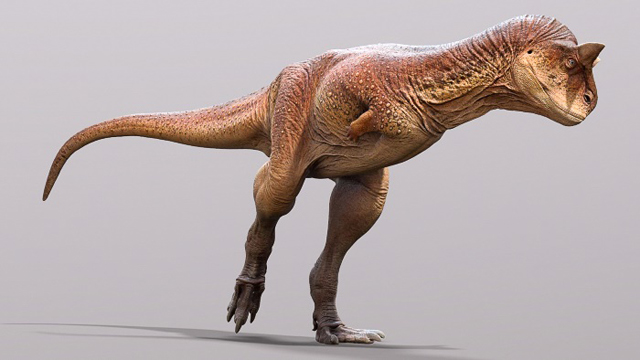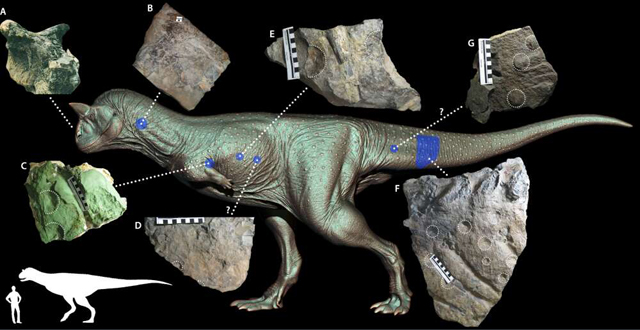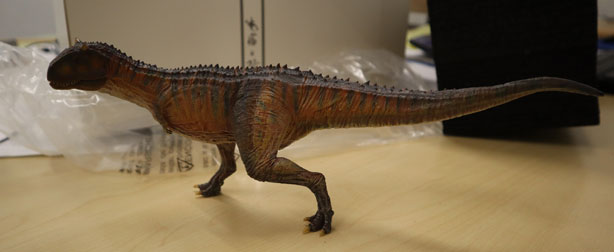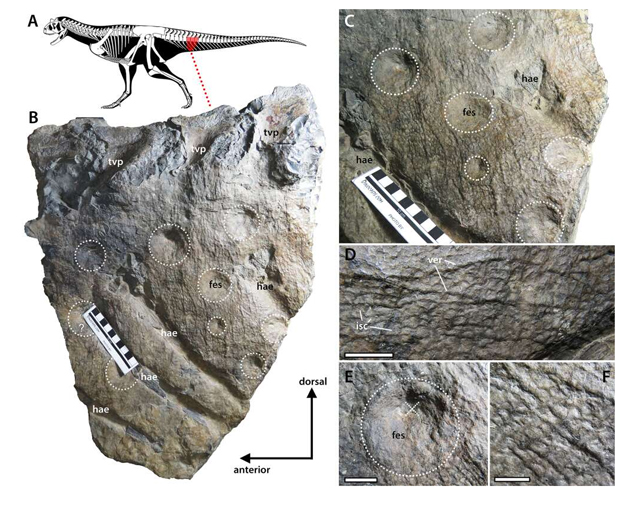Carnotaurus Skin Study
In 1984, a field team led by the renowned Argentinian palaeontologist José Bonaparte uncovered the fossilised remains of a theropod dinosaur in Chubut Province (Patagonia). The articulated fossil remains included most of the front-portion of the skeleton and although some of the bones had been deformed and distorted due to taphonomic processes, skin impressions of parts of the right side of the animal had been preserved. Skin impressions associated with the head of this dinosaur were also present, but these were not recognised during laboratory preparation and sadly they were lost as the skull fossils were cleaned and prepared.
A year later, Carnotaurus (C. sastrei) was formally named and described. Remarkably, despite the Carnotaurus skin impressions being the most completely preserved of any theropod, no detailed study of the skin had been undertaken.
All that changed this week with the publication of a scientific paper in the journal “Cretaceous Research”.

Not a Feather to be Found
Palaeontologist Dr Christophe Hendrickx from the Unidad Ejecutora Lillo in San Miguel de Tucumán (Argentina), worked with Dr Phil Bell from the University of New England (New South Wales, Australia), an expert in dinosaur integumentary coverings. Whilst the skin impressions only cover part of the body, (the largest skin impression is associated from the base of the tail), the scientists were able to determine that the skin covering consisted of a diverse range of scales and bumps of different shapes and sizes.
No evidence for any bristle-like structures or feathers could be found.

Dr Hendrickx remarked:
“By looking at the skin from the shoulders, belly and tail regions, we discovered that the skin of this dinosaur was more diverse than previously thought, consisting of large and randomly distributed conical studs surrounded by a network of small elongated, diamond-shaped or sub-circular scales.”
Have Carnotaurus Model Makers Got it All Wrong?
Contrary to previous interpretations and the attempts of model makers to depict Carnotaurus, the feature scales are randomly distributed and neither form discrete rows nor show progressive variations in their size along parts of the body. All those illustrations and replicas of Carnotaurus with a neat row of spines running down its back are not accurate according to the conclusions drawn from this research.

The picture above shows a Carnotaurus replica in the Nanmu Studio Jurassic Series range.
To view this range: Nanmu Studio Dinosaur Models.
Picture credit: Everything Dinosaur
Carnotaurus Skin – Reminiscent of a Thorny Devil
The composition of the skin and the morphology of the scales reminded the researchers of the integument of the Australian lizard the Thorny Devil (Moloch horridus). This small, spiny lizard which is relatively common in the deserts of western and central Australia, uses its spines primarily for defence. It would be difficult for any would-be predator to swallow it. Grooves between the spines allow the lizard to channel water to its mouth, a useful adaptation when living in an environment with infrequent rain.

At around 8 metres in length and since Carnotaurus is regarded as the apex predator in its environment, it is unlikely that the lumps and bumps on the skin were primarily for self-defence, but protection from intraspecific combat cannot be ruled out. However, recent studies have shown that Carnotaurus was a strong runner. If this large dinosaur had a very active lifestyle, then helping to regulate body temperature and permit heat-loss would have been very important.
Playing a Role in Thermoregulation
The researchers speculate that the skin may have played a vital role in thermoregulation, a role consistent with integument function in living mammals and reptiles.

The scientific paper: “The scaly skin of the abelisaurid Carnotaurus sastrei (Theropoda: Ceratosauria) from the Upper Cretaceous of Patagonia” by Christophe Hendrickx and Phil R. Bell published in Cretaceous Research.
Visit the Everything Dinosaur website: Everything Dinosaur.

